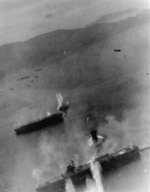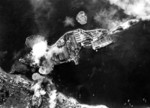Amagi
| Country | Japan |
| Ship Class | Unryu-class Aircraft Carrier |
| Builder | Mitsubishi Nagasaki Shipyard |
| Laid Down | 1 Oct 1942 |
| Launched | 15 Oct 1943 |
| Commissioned | 10 Aug 1944 |
| Sunk | 29 Jul 1945 |
| Displacement | 22,534 tons standard; 22,800 tons full |
| Length | 745 feet |
| Beam | 72 feet |
| Draft | 25 feet |
| Machinery | Steam turbines, 8 boilers, 4 shafts |
| Power Output | 152,000 shaft horsepower |
| Speed | 34 knots |
| Range | 9,700nm at 18 knots |
| Crew | 1,595 |
| Armament | 6x127mm, 51x25mm anti-aircraft |
| Aircraft | 57 operational, 6 in reserve |
Contributor: C. Peter Chen
ww2dbaseAmagi was named after the town of Amagi, Fukuoka, Japan and was built by Mitsubishi at Nagasaki. Under the command of Captain Kamenosuke Yamamori, she joined Carrier Division 1 of the Third Fleet in August 1944, immediately following completion. She carried 23 A6M Zero fighters, 21 D3A dive bombers, and 21 B6N torpedo bombers. Between Aug and Oct 1944, she was the flagship of Vice Admiral Jisaburo Ozawa's Mobile Fleet. On 23 Oct 1944, Captain Toshio Miyazaki was named the commanding officer of the ship. On 20 Dec 1944, Rear Admiral Sueo Obayashi of Carrier Division 1 made Amagi his flagship, 10 days after he took over the division. After torpedo attack exercises, she arrived at Kure, Japan on 10 Feb 1945, where she was relieved of flagship duty. On 15 Mar, she joined the 2nd Fleet.
ww2dbaseOn 19 Mar 1945, while at anchor, Amagi was attacked by American aircraft. One bomb hit on the flight deck at starboard aft jammed the aft elevator in the down position. Her gunners claimed 12 kills, though the number was likely inflated.
ww2dbaseBy Apr, due to the lack of aircraft and escorts, Amagi was deemed ineffective for the war effort, and entered semi-permanent mooring status. On 13 Apr, camouflaging work on her began, which included fake trees, houses, and streets. On 20 Apr, Captain Shiro Hiratsuka took over command of Amagi as Captain Miyazaki became the commanding officer of both Amagi and Katsuragi at Kure. Crews of both ships were reduced to minimum.
ww2dbaseIn the morning of 24 Jul 1945, Amagi was attacked by American carrier-based aircraft from Task Force 38. She was damaged by near-misses on both sides at the onset of the attack, including a port side near-miss that blasted a hole 15 feet below the water line and flooded the forward bomb magazine. At about 1000, she was struck by two bombs. The first, a 500-pound bomb, detonated, in the starboard passageway, damaging the No. 2 stack and opened a hole in the starboard hull. The second bomb, the larger bomb, detonated on the centerline amidships, penetrating 25 feet and exploded close to the upper hangar deck, causing serious structural damage. At about 1200, the order to abandon ship was given as bombs continued to fall, causing near-misses that further damaged the ship. The evacuation was completed at 1530. By the end of the attack, her flight deck was completely destroyed, and she suffered a slight list to port due to flooding, but she did not sink, largely thanks to the lack of widespread fire. Over the next few days, flooding became progressively worse, but she remained upright.
ww2dbaseOn 28 Jul, aircraft from Task Force 38 returned for another raid. Amagi received one or two direct bomb hits and many near-misses. The exact details of the damage were unclear due to the ship's status as already abandoned (only a small firefighting team from Kure Navy Yard was aboard), but it was apparent that flooding was now uncontrollable. Her list to port grew worse, and by the morning of 29 Jul, her bow was dipping below the water surface. At 1000 on 29 Jul 1945, she capsized to port and ran aground, dumping her damaged flight deck into the water and exposing her starboard screws.
ww2dbaseAfter the sinking, only one officer and four petty officers were assigned to Amagi as her caretaker crew. After the war, she was inspected by Americans on 13 Oct 1945, then was refloated in Dec 1946 for scrapping, which completed on 12 Dec 1947.
ww2dbaseSource: Imperial Japanese Navy Page.
Last Major Revision: Oct 2007
Aircraft Carrier Amagi Interactive Map
Photographs
 |  |  |  |
Amagi Operational Timeline
| 10 Aug 1944 | Amagi was commissioned into service. |
| 14 Jul 1945 | American battleships USS South Dakota, USS Indiana, and USS Massachusetts and escorting destroyers bombarded Kamaishi, Honshu, Japan; the primary target was the Kamaishi Works of the Japan Iron Company, but several destroyers shells overshot the target and hit the town, killing many civilians; battleship shells were more accurate, destroying about 65% of the industrial complex, but they also killed many civilians; this was the first time the Japanese home islands were subjected to naval bombardment. To the north, the sinking of 6 warships and 37 steamers on the ferry route between Honshu and Hokkaido islands effectively cut off the latter from the rest of the home islands. At Kure in southern Japan, aircraft of US Navy TF 38 damaged carrier Amagi, carrier Katsuragi, and battleship Haruna; at Misawa in northern Japan, G4M bombers that were assigned to partake the planned Operation Ken, which sought to deliver 300 suicide commandos to the Mariana Islands, were destroyed (the American would not know of Operation Ken until after the war). The carriers were escorted by a large naval force that included battleship USS Missouri. Far to the south, the USAAF XXI Bomber Command canceled a long-range P-51 raid from Iwo Jima to attack Meiji and Kagamigahara near Nagoya due to poor weather. |
| 24 Jul 1945 | British TF 37 launched 416 sorties, 261 of which were sent against the Japanese home islands and 155 were for defensive patrols; escort carrier Kaiyo was damaged by British carrier planes. On the same day, American TF 38 launched 600 aircraft against Kure, Nagoya, Osaka, and Miho, sinking battleship-carrier Hyuga, heavy cruiser Tone, and target ship Settsu, and damaging carrier Ryuho, carrier Amagi, battleship-carrier Ise, battleship Haruna, heavy cruiser Aoba, light cruiser Oyodo, transport Kiyokawa Maru; the Aichi aircraft factories at Nagoya were seriously damaged. |
Você gostou deste artigo ou achou este artigo útil? Se sim, considere nos apoiar no Patreon. Mesmo USD $1 por mês já vai longe! Obrigado. Por favor, ajude-nos a espalhar a palavra: Fique atualizado com WW2DB: |
» Preparations for Invasion of Japan
Document(s):
» Japanese Aircraft Carrier Functions
» Japanese Aircraft Carrier Operational Status By Month
» Japanese Aircraft Carrier Specifications
» Japanese Aircraft Carrier Time Operational
Partner Sites Content:
» Amagi Tabular Record of Movement
- » 1,167 biographies
- » 337 events
- » 44,617 timeline entries
- » 1,244 ships
- » 350 aircraft models
- » 207 vehicle models
- » 376 weapon models
- » 123 historical documents
- » 261 facilities
- » 470 book reviews
- » 28,517 photos
- » 365 maps
Joachim von Ribbentrop, German Foreign Minister, Aug 1939
Por favor, considere nos apoiar no Patreon. Mesmo R$1 por mês já faz uma grande diferença. Obrigado!
Ou, por favor, nos apoie adquirindo alguns produtos do WW2DB na TeeSpring. Obrigado!